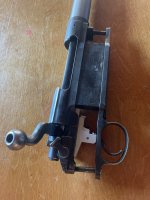yes....
maybe lay a lapping bar or 1" rod of sorts in the rings to try and see that they are in-line properly?
3x with the same symptom in the scope must be a record, did Hirsch offer any clue? bent or crushed tubes?
That’s what I thought as well, 3x seems pretty odd. It happen twice on a 375-338, same scope twice (vxiii 2.5-8x36), and once on my H&H and its scope (vx3 1.75-6x32). Each has their own talley light weight mounts on them.
I do test with line up bars when mounting a scope, but I have not lapped any mounts.
Korth fixed the vx iii both times, I sold it after the second time. The vx3 I sent in, it came back worse then it left. I sold it as a broken scope that needed re work. All 3 scopes they stated they replaced the reticles iirc, I don’t remember (I don’t think) anything else was replaced. They didn’t mention anything about distorted or bent tube
I use the line up pins to be sure both mounts are in line, but haven’t used the lapping bar. Next time I mount a scope in one I will try lapping first maybe.
This^ Check the rings for a burr or uneven spots that create pinch points and uneven stresses. A 1" or 30mm hardened steel machining dimension rod would be helpful. Put the rod in each of the rings, and check if you can see light between the ring and the rod. If you can, the ring is misshapen/distorted or has an uneven spot - all of which can affect the tube differently, especially under the thump of the 375, and possibly the internals or seals of the scope as well. Check both rings separately, and together.
EDIT. Also, level the rifle using the rail or bases you have as your even point. Put on the rings at the same spacing as for the scope. Tighten them down, place the test bar in them and measure to see of it's level. If not, then you may have to engage in some shimmage or ring lapping.
Next, measure the actual diameter of your tube. Your "very near" (Vernier) calipers you use for reloading should be good, but a mic would be better. The tube should be exactly 1 inch or 30mm (depending on the variant. While I would trust the 30mm to be 30mm, the 1 inch might well be 25mm not 25.4, so the torque may affect it differently - you may be getting pinch points or eccentricity, or it may not be holding it tightly enough and the scope is accelerating with each thump.
Then, I would take and check the eccentricity of the problem tubes. Make a pencil mark on the top of the tube to clock your measurements. Measure diameter in the vertical direction and then at 90 degrees to that (horizontal). They should be within a thou or two, else your rings are likely distorting the shape of the tube, weakening it and possibly applying stress on the inside. The interior of the scope is sealed and under pressure with gas (N2 or argon). If you distort the tube enough, the seals may... unseal and let moisture inside.
Finally, I'd check the tube for high/low spots. Take two parallels, place them on a flat plane. Make sure the parallels are taller than the height of the turrets. Place the scope so that the tube rests on the parallels. Roll the scope slowly through 360 degrees. Look for uneven rolling or a jump. If there is, this should give you an indication that your rings are distorting the tube in some way. A surface plate and machinist's parallels would be best, but any kitchen counter and two identical bars of material will do.
Of course, if you have access to a machine shop and dial indicators, you can make all this more exact than this, but that is what I would do.
Thank you for taking the time to write this!! Really appreciate it! A few thins here I’ll look into.
I don’t have any of the previous scopes any more, but am looking to top one of these .375’s right quick and try again before moose season.
I will give these mounts a go though again, maybe I’ll hit them with the lapping bar just to be sure there are no burr’s










































































